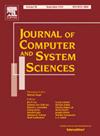时间可达性支配集:时间图中的传染
IF 0.9
3区 计算机科学
Q1 BUSINESS, FINANCE
引用次数: 0
摘要
给定具有动态两两连接的种群,我们问整个种群是否会(间接)被k个初始感染个体的一小群感染。我们将这个问题形式化为时间图上的时间可达性支配集问题。我们提供了四个不同参数的正负参数化复杂度结果:初始感染的数量k、图的生命周期τ、图中局部最早边的数量和足迹图的树宽G↓。我们还引入并研究了MaxMinTaRDiS问题,该问题的目标是调度个体之间的连接,使整个群体至少感染k个个体才能完全感染。我们把这个问题分为三种:严格、不严格和快乐。我们分别证明它们是cp完全的、np困难的和Σ2P-complete。有趣的是,我们通过证明一个自然约束正是静态图上的距离-3独立集问题得到了非严格变量的硬度。本文章由计算机程序翻译,如有差异,请以英文原文为准。
Temporal Reachability Dominating Sets: Contagion in temporal graphs
Given a population with dynamic pairwise connections, we ask if the entire population could be (indirectly) infected by a small group of k initially infected individuals. We formalise this problem as the Temporal Reachability Dominating Set (TaRDiS) problem on temporal graphs. We provide positive and negative parameterized complexity results in four different parameters: the number k of initially infected, the lifetime τ of the graph, the number of locally earliest edges in the graph, and the treewidth of the footprint graph . We additionally introduce and study the MaxMinTaRDiS problem, where the aim is to schedule connections between individuals so that at least k individuals must be infected for the entire population to become fully infected. We classify three variants of the problem: Strict, Nonstrict, and Happy. We show these to be coNP-complete, NP-hard, and -complete, respectively. Interestingly, we obtain hardness of the Nonstrict variant by showing that a natural restriction is exactly the well-studied Distance-3 Independent Set problem on static graphs.
求助全文
通过发布文献求助,成功后即可免费获取论文全文。
去求助
来源期刊

Journal of Computer and System Sciences
工程技术-计算机:理论方法
CiteScore
3.70
自引率
0.00%
发文量
58
审稿时长
68 days
期刊介绍:
The Journal of Computer and System Sciences publishes original research papers in computer science and related subjects in system science, with attention to the relevant mathematical theory. Applications-oriented papers may also be accepted and they are expected to contain deep analytic evaluation of the proposed solutions.
Research areas include traditional subjects such as:
• Theory of algorithms and computability
• Formal languages
• Automata theory
Contemporary subjects such as:
• Complexity theory
• Algorithmic Complexity
• Parallel & distributed computing
• Computer networks
• Neural networks
• Computational learning theory
• Database theory & practice
• Computer modeling of complex systems
• Security and Privacy.
 求助内容:
求助内容: 应助结果提醒方式:
应助结果提醒方式:


